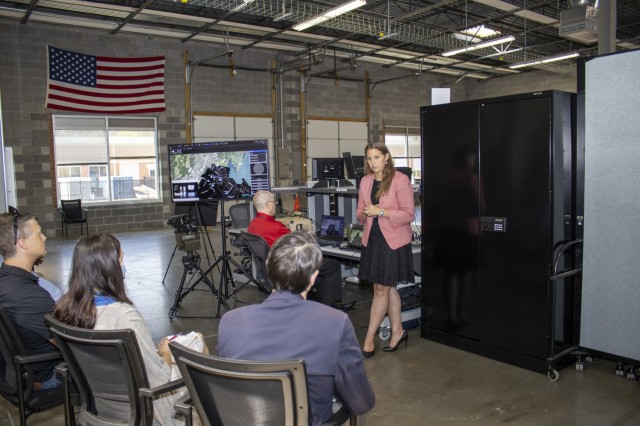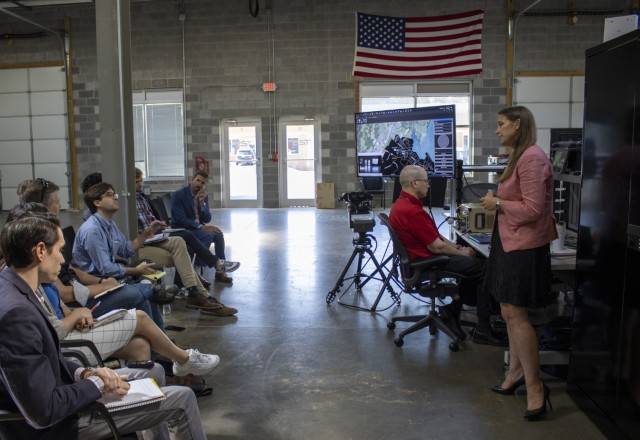Link to original article: https://www.usajobs.gov/job/704587000
The Army’s Integrated Sensor Architecture – a comprehensive framework for integrating various sensors into the Army’s network-centric systems on display during a presentation by Christine Moulton, Lead Open Architectures and Standards in the Integration Directorate at Program Executive Officer Intelligence, Electronic Warfare and Systems, Aberdeen Proving Ground, Maryland. (Photo Credit: US Army)
Christine Moulton, Lead Open Architectures and Standards in the Integration Directorate at Program Executive Officer Intelligence, Electronic Warfare and Systems showcase the Army’s Integrated Sensor Architecture – a comprehensive framework for integrating various sensors into the Army’s network-centric systems. (Photo Credit: US Army )
Developers and engineers at the Program Executive Office Intelligence, Electronic Warfare and Sensors (PEO IEW&S) Integration Directorate have been modernizing the US Army’s Integrated Sensor Architecture (ISA) to meet interoperability demands of the future warfighter. ISA is a comprehensive framework for integrating various sensors into the Army’s network-centric systems. It was designed to improve the collection, dissemination, and use of sensor data for enhanced situational awareness and decision-making. The ISA framework includes standards for sensor data and communication protocols, allowing different sensors to interoperate and share information.
ISA aims to improve the Army’s ability to operate in complex environments and respond to changing tactical situations, ultimately enhancing its capabilities to defend the nation.
“ISA enables the warfighter to more quickly adopt and share information between sensors on the battlefield,” said Christine Moulton, Lead Open Architectures and Standards in the Integration Directorate at PEO IEW&S. “It also enables faster upgrades in capabilities by allowing individual sensors/capabilities to be adopted more quickly to fielded systems.”
ISA provides the ability of sensors from different manufacturers to work together seamlessly and exchange data. This enables a more efficient and effective integration of sensors in a system, improving the overall performance of the system. Interoperability is achieved through the use of standardized communication protocols and interfaces, which allow different sensors to understand each other and share information. This has numerous benefits, such as increased flexibility, reduced costs, and improved reliability, making it an important aspect in the design and deployment of sensor systems. In addition to facilitating the rapid exchange of sensor data among Soldiers, the technology behind ISA assists the warfighter by reducing the number of systems Soldiers need to rely on downrange.
“ISA enables devices to talk directly to each other without having to rely on a ‘middleman’ or some system at a higher echelon to do a translation for them,” said Matthew Harrell, Sensor CE & ISA Tech Lead at PEO IEW&S. “If leveraged correctly, this can dramatically reduce the latency and time for sensor-supplied information to be usable by the Solider since they will not have to rely on local and remote ‘translators’ to process the sensor information and provide it back to them.” This will reduce the number of systems needed to be deployed and managed by Soldiers, he added.
Currently, the Army’s vast number of sensors and systems operate in an exclusive, proprietary environment. They were not developed to “discover” and/or “interact” with other external systems or devices. ISA, however, addresses this barrier to sensor modernization with a modular and adaptable framework that is usable by any type of sensor.
“One of the most powerful things about ISA is the way it’s designed, its break-apart services that provide these fundamental capabilities — dynamic discovery, subscription, tasking, and etc.,” Moulton said. “And with the way it’s designed, we can easily add on new services.”
One unusual feature of ISA is that it’s designed to operate in a tactical environment. Developers started building ISA with a specific focus on the lower tactical edge of the battlefield where low bandwidth and a constantly changing physical network hampers connectivity.
“We designed ISA to work on that lowest common denominator first, because it’s better to solve the hard problem and then scale it up,” explained Moulton.
Deployment of ISA moves the Army closer to a future where sensors intuitively interact with each other in new and novel ways. These interactions allow sensors to increase the amount of automation and enable the use of more complex emerging technology such as artificial intelligence algorithms and machine learning. To keep pace with ever-changing technologies, the Sensor CE team consistently reviews government standards on the acquisition of commercial applications as well as their own data models and structures looking for ways to improve the process.
Typically, Moulton explained, a communications standard establishes rules for how a device would connect to the network and how their information would be exposed. Many systems are required to support multiple standards increasing the complexity of the system. The ISA design, in contrast, calls for all entities to use the same language, provides well-defined requirements for compliance with the standard, and includes testing tools to enable rapid system integration. Moulton noted that ISA has a data model that can be adapted to cover any sensor data but ensures there is only one way to implement any capability. That streamlined approach in device identification and communication also applies in ISA’s data structures. ISA enabled sensors “…describe a set of capabilities that are provided by a sensor” she said. The definition of a radar, for example, can vary quite heavily by community. By using ISA, a sensor would report what it is capable of doing – it can detect movement, it has a range, it is able to recognize targets in this area of regard, etc.
“There are two fundamentals were trying to fix in designing ISA. One is, how do we allow only one way for you to provide information, so the position is always represented this way, so there’s no argument about it,” Harrell said. “But at the same time, how do we make it extensible, so others can add new data types, experiment with what makes sense, get the right thing going, and then turn around and add those to the standard without breaking everybody else.”
Harrell said it’s not cost effective to reengineer everything every few years to accommodate new sensors and new capabilities. He envisions ISA being designed to avoid that.
“Every device that comes on the network [consistently] describes what it is capable of doing,” he said. “So, if you design a system today that can ingest data and then add a sensor ten years from now, and they are still able to plug-in together and work together, that is what we are trying to design here, something that can be extensible and can allow this kind of future proofing for new technology coming out.”
ISA has the potential to work with all the sensors in the PEO IEW&S portfolio and Sensor CE is in the process of engaging in Program Management Offices throughout the organization.
“We are providing it as a capability that can be used on any type of sensor, anything in the PEO’s portfolio ranging from the biometric sensors to aircraft survivability to the electronic warfare sensors, all of those can work with ISA,” Harrell said. “We are talking to all of the Project Managers to make sure they understand that this capability exists and so that they can leverage it.”
ISA is currently deployed to several programs within the PEO IEW&S portfolio. It is also in use at Joint Program Executive Office for Chemical, Biological, Radiological and Nuclear Defense, Program Executive Office Missiles & Space, in programs under the United States Air Force and the United States Navy, and in a joint-collaboration capacity within the Department of Homeland Security. Future deployments include systems under Program Executive Office Command Control Communications, Army G-2 and the United States Marine Corps, to name a few.
Sensor CE is also looking at new projects in development like the High Accuracy Detection and Exploitation System (HADES) where ISA can be implemented at the onset.
“The HADES program is still in the process of defining their requirements and now is a good time for them to look at ISA, to take what we have in there, to update what they’ve got so they can leverage it and make sense of it, and supply whatever information they need to us,” Harrell said.
HADES is a future aerial intelligence, surveillance, and reconnaissance system currently in development.
For additional information or inquiries related to the PEO IEW&S Integration Directorate’s Integrated Sensor Architecture, please contact the team at e-mail: usarmy.apg.peo-iews.mbx.hq-sensor-ce-support@army.mil.


